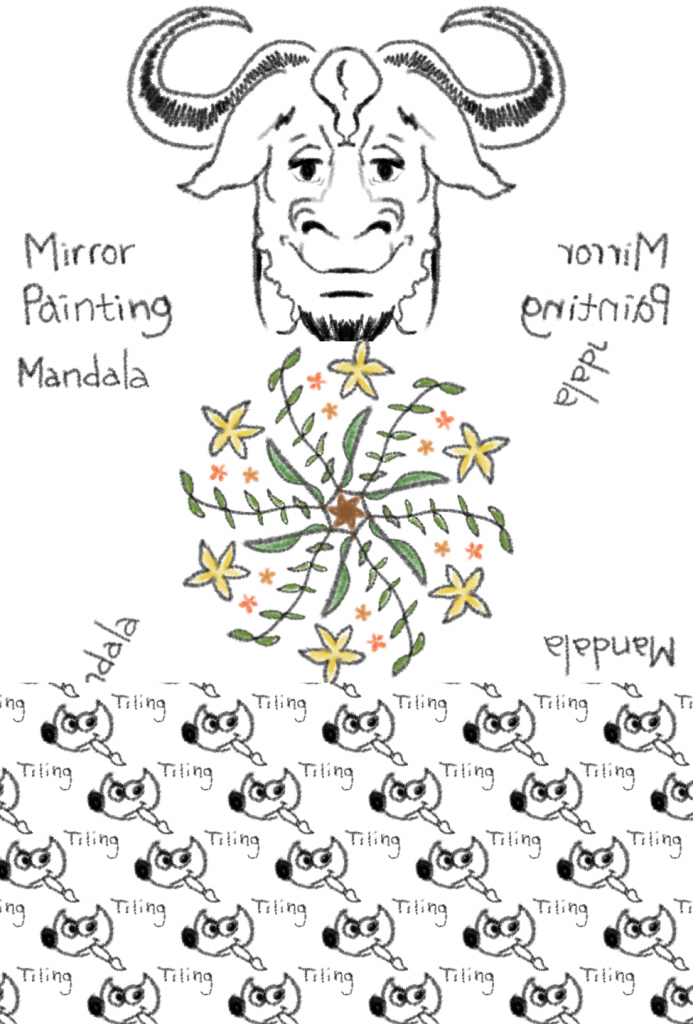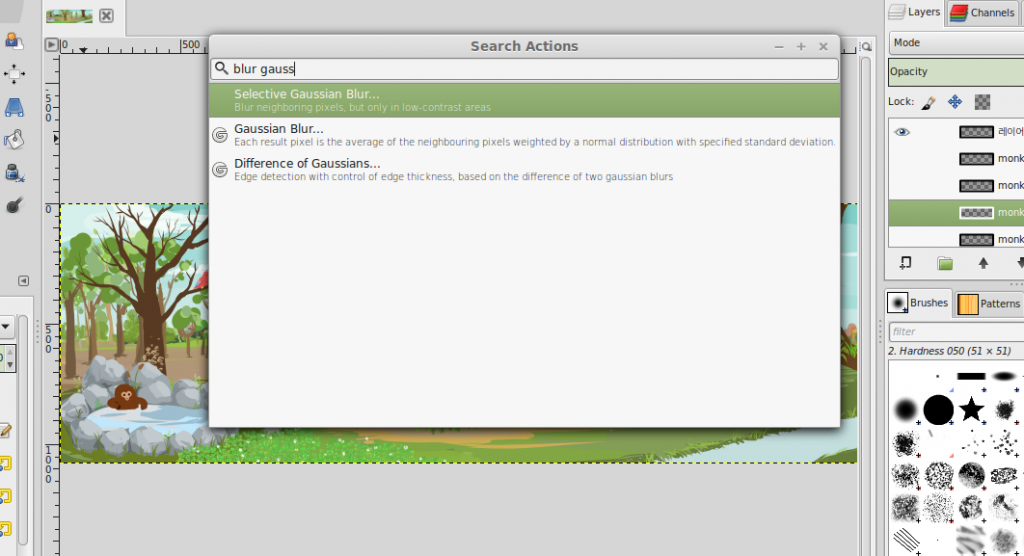So you may have heard the news: we recently released a new development version of GIMP, version 2.9.4 (as well as a bugfix release 2.8.18, but this is not as awesome).
Small edit: I realized that my blog post has been linked on many major news website. I didn’t expect this! Therefore I just want to make clear that whatever I wrote below is my view of GIMP future. It may not be shared by other developers who have their own priorities and this post has not be written with the other devs. In other word, anything here is not written as anything official from the GIMP project itself, but from me only, a single contributor to GIMP.
GIMP 2.9.4
I am not going to rewrite all of the official news, because you may as well read it on gimp.org. Anyway I co-wrote the news with the rest of the team and provided several screenshots. So reading there is also partly same as reading here. 😉
I’ll just illustrate with this cool picture of the live preview of operations (here a gaussian blur) directly on canvas, split for comparison, implemented by Mitch, our own benevolent dictator (or are we all his dictators?). The image on canvas is by Aryeom, ZeMarmot‘s director.

Pretty cool feature, uh?
GIMP & ZeMarmot project
As you can read on gimp.org, ZeMarmot is a contributor to GIMP through my own contributions (which amounts to about 14% of commits for this specific release. Commits number is not always the most perfect metrics but as good as any).
Painting
So what did we bring to the table? Well there are the stuff which we like most first: painting. So I developed symmetry painting last year. Here are some symmetrical doodles drawn by Aryeom in just a few seconds, thanks to the symmetry modes:

I also helped on the integration of the MyPaint brushes, and in particular contributed upstream on a whole build system rework which, as a side effect improved the codebases of libmypaint and MyPaint (quote from Mypaint’s blog post):
Development of MyPaint will continue of course; in fact making this split happen has improved a lot of things in the codebases of both projects ☺ Big thanks to @Jehan for making this all work so well!
Internationalization
Also the fact that Aryeom is Korean, that we both lived in several countries in Europe, Asia and Oceania, that we speak English, French, Japanese, Korean (well my Korean is lacking!), and that I love languages and am a grammar geek made us good targets to notice anything wrong with GIMP’s support of non Western languages. So I have fixed some bugs and even crashes related to Input Methods and made the text tool finally compliant with input method engines (it used to have an ugly overlay box, not integrated at all in the input box, and without any standard formating).

Of course, I did several other fixes related to languages since I contribute to GIMP like each language translated in itself in the list of language in the preference, or bugs with GUI with right-to-left languages, like Arabic (did I say I was a language geek? I love all these differences and particularities).
Other than this, both Aryeom and I are trying to build a more diverse community by engaging FLOSS and GIMP enthusiasts in Japan, South Korea (some tutorial videos in Korean even) or other countries in their native languages. A hard and long job but we are trying. 🙂
Code review and code maintenance
Well I code a lot of other stuff, smaller features (like the email plugin in GIMP 2.9.4, using xdg-email, implemented a few weeks ago) and bug fixes since I like GIMP hard-rock solid and as stable as possible but that’s obviously less visible. I am also trying to step up more and more for code review and maintenance of small pieces of the software, since Mitch really needs the help (apparently the whip is not enough help! Go figure!). Well this is still work in progress and I wish I could make time to bring more cool code into GIMP, but it still allowed the action search (equivalent to the space-menu of Blender), which I think is one of the coolest feature of GIMP 2.9/2.10 and making menus so old school. This was originally contributed by Srihari, then I reviewed, rewrote and fixed parts of it to fit our high standards on code quality. Well I think that’s one of the features I am the most proud as a reviewer (instead of as the original author). This is also very rewarding to work with other coders, especially when talented and with interesting ideas.

There are more code I reviewed and integrated, like lately the cool command line’s batch processing macro or even the whole revamping of the user interface (new themes and icons). Arguably this is less “useful”. Well it depends. I met some people who claimed it will change their life, while others would hate the new design direction (though note that old icons and theme are still available in preferences). But anyway this was an idea hanging around on mailing list for years, so I took on myself to attend to new contributors willing to help on the matter (Klaus Staedtler for the icons and Benoit Touchette for the themes). This is also an interesting adventure, I think.

In the end working on all these fronts is very cool but also exhausting. Hopefully the more time goes, the more I will be able to do! 🙂
Future of GIMP
GEGL everywhere?
I see a lot of good things happening around GIMP. And not just from me, but from all the awesome people in GIMP team and projects around. GEGL for one is a hell of a cool project and I think it could be the future of Free and Open Source image processing. I want to imagine a future where most big graphics program integrates GEGL, where Blender for instance would have GEGL as the new implementation of nodes, with image processing graphs which can be exchanged between programs, where darktable would share buffers with GIMP so that images can be edited in one program and updated in real time in the other, and so on.
Well of course the short/mid-term improvements will be non-destructive editing with live preview on high bit depth images, and that’s already awesomely cool right?
Painting again, better UI, export and much more…
Of course we want to go further for painting features and workflow improvement, but also the UI which really needs some reworking here and there (which is also why I created the gimp-gui mailing list, meant to discuss all sort of topics UI and UX related). That also includes improving support for graphics tablet and alike.
I also have a lot of ideas, some may come to be implemented in a form or another, or not (the export process for instance is still untouched for now). Even when this happens, it’s ok: contributing to Free Software is not just adding any random feature, that’s also about discussing, discovering others’ workflow, comparing, sometimes even compromising or realizing that our ideas are not always perfect. This is part of the process and actually a pretty good mental builder. In any case we will work hard for a better GIMP. 🙂
Among the many other features we are really keen on are the ability to select many layers at once (this is often a pain for Aryeom, since she usually works with many dozens of layers when animating), macros, improving the API to be able to customize the GUI (and not only adding menu items) and the behavior of GIMP, get more communication between GIMP and plugins and in general reacting to hooks, and much much more.
Now there are stuff which are also cool, like better HiDPI support but since we don’t own a HiDPI screen anyway, this is harder to test.
Also I like GIMP for being generic. While other programs choose to be specialized, which is a valid choice, we can notice most graphics programs end up with the same features in the end anyway. Indeed brushes and other painting features are actually very useful to photographers as well. On the other hand, painters regularly use filters and transformation tools originally thought for photographers. Designers use everything as well. So I think the approach of a program which aims to do everything well is quite acceptable too.
Well you see, we have a lot of plans about GIMP, that seems nearly impossible but that’s exciting. And of course, there are the plugins for animation that I am working on, on a good pace. I think I will be able to present the main GIMP plugin for animation quite soon on this website. Stay tuned! 🙂
Help us by helping ZeMarmot?
As often, I will conclude by promoting our permanent monthly funding of ZeMarmot. I know this is very annoying! We want to make a difference, something cool: a Libre animation film together with Free Software code. And trying to make this into more than just a hobby. Right now we are barely there.
I regularly talk about the more “artistic” side here, not often enough about the “technical” coding side. So I decided to use the opportunity of GIMP 2.9.4 release to make this small (non exhaustive) report of stuff I had been doing these last months and what are our goals on the software side (GIMP in particular). If you like what you read here about my contributions, then you like what ZeMarmot is doing, because this is all the same project. And therefore if ever you can afford it, we would welcome financial help so that we can continue software development as well as the production of the animation film.
We are on 2 platforms allowing monthly subscription (which you can stop anytime, as soon as you don’t like us anymore!): Tipeee where you can contribute in EUR (€) and Patreon where you can contribute in USD ($). Note that our pitch is written in French on Tipeee but that’s the same project anyway. Just read the official website in English or the Patreon page.


That’s it for today! I hope you enjoyed my coding report on GIMP. Enjoy your week-end everyone! 🙂

